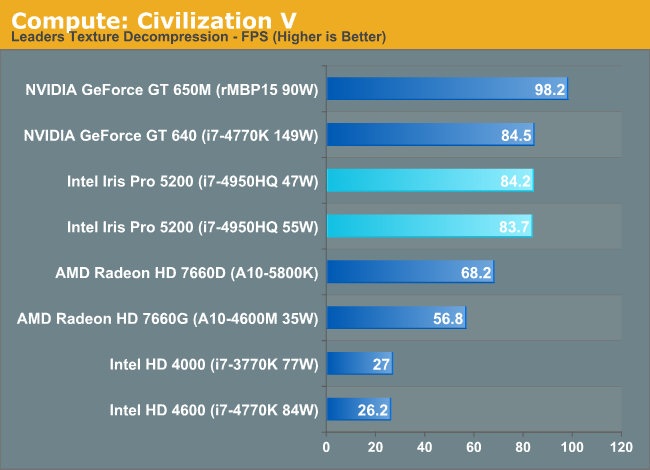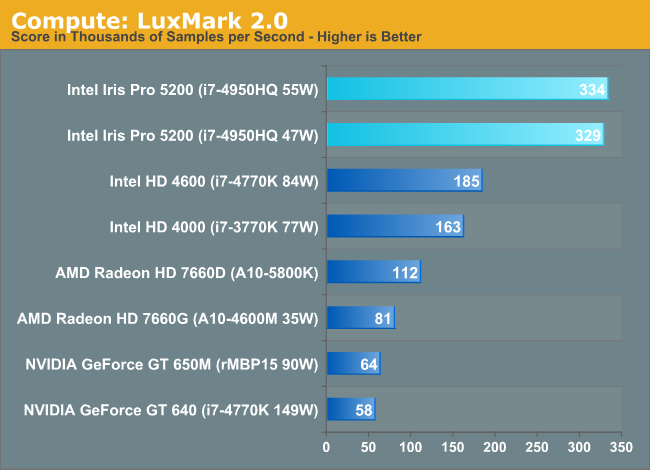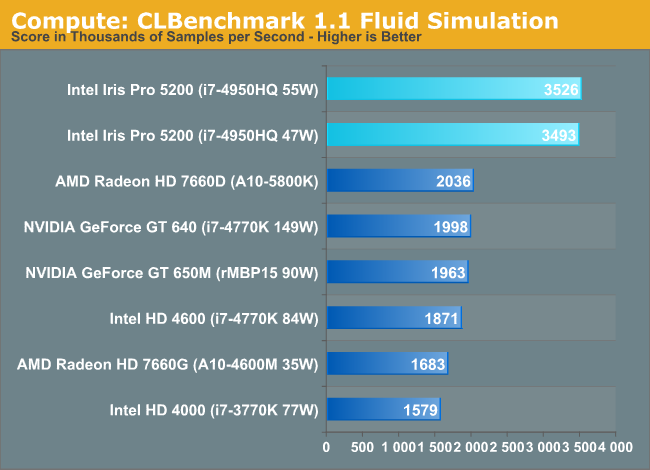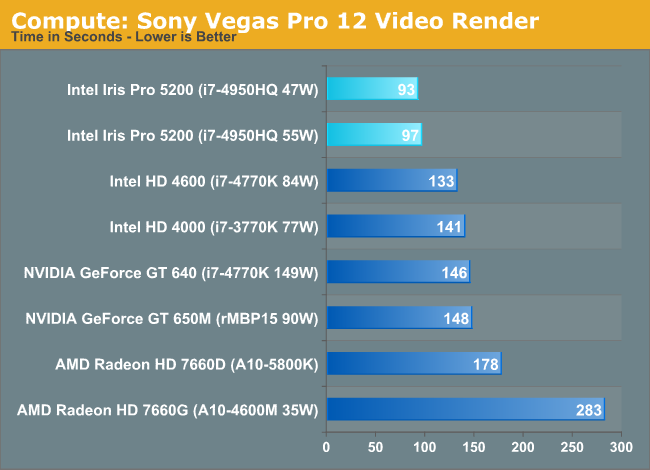Intel Iris Pro 5200 Graphics Review: Core i7-4950HQ Tested
by Anand Lal Shimpi on June 1, 2013 10:01 AM ESTCompute Performance
With Haswell, Intel enables full OpenCL 1.2 support in addition to DirectX 11.1 and OpenGL 4.0. Given the ALU-heavy GPU architecture, I was eager to find out how well Iris Pro did in our compute suite.
As always we'll start with our DirectCompute game example, Civilization V, which uses DirectCompute to decompress textures on the fly. Civ V includes a sub-benchmark that exclusively tests the speed of their texture decompression algorithm by repeatedly decompressing the textures required for one of the game’s leader scenes. While DirectCompute is used in many games, this is one of the only games with a benchmark that can isolate the use of DirectCompute and its resulting performance.

Iris Pro does very well here, tying the GT 640 but losing to the 650M. The latter holds a 16% performance advantage, which I can only assume has to do with memory bandwidth given near identical core/clock configurations between the 650M and GT 640. Crystalwell is clearly doing something though because Intel's HD 4600 is less than 1/3 the performance of Iris Pro 5200 despite having half the execution resources.
Our next benchmark is LuxMark2.0, the official benchmark of SmallLuxGPU 2.0. SmallLuxGPU is an OpenCL accelerated ray tracer that is part of the larger LuxRender suite. Ray tracing has become a stronghold for GPUs in recent years as ray tracing maps well to GPU pipelines, allowing artists to render scenes much more quickly than with CPUs alone.

Moving to OpenCL, we see huge gains from Intel. Kepler wasn't NVIDIA's best compute part, but Iris Pro really puts everything else to shame here. We see near perfect scaling from Haswell GT2 to GT3. Crystalwell doesn't appear to be doing much here, it's all in the additional ALUs.
Our 3rd benchmark set comes from CLBenchmark 1.1. CLBenchmark contains a number of subtests; we’re focusing on the most practical of them, the computer vision test and the fluid simulation test. The former being a useful proxy for computer imaging tasks where systems are required to parse images and identify features (e.g. humans), while fluid simulations are common in professional graphics work and games alike.


Once again, Iris Pro does a great job here, outpacing everything else by roughly 70% in the Fluid Simulation test.
Our final compute benchmark is Sony Vegas Pro 12, an OpenGL and OpenCL video editing and authoring package. Vegas can use GPUs in a few different ways, the primary uses being to accelerate the video effects and compositing process itself, and in the video encoding step. With video encoding being increasingly offloaded to dedicated DSPs these days we’re focusing on the editing and compositing process, rendering to a low CPU overhead format (XDCAM EX). This specific test comes from Sony, and measures how long it takes to render a video.

Iris Pro rounds out our compute comparison with another win. In fact, all of the Intel GPU solutions do a good job here.










177 Comments
View All Comments
tipoo - Saturday, June 1, 2013 - link
It still seems to me that this misses where it would benefit most: 13 inch laptops, which currently mostly use dual core processors. GT3e would make something like the Retina MBP 13" much more appealing for instance, but it's paired with processors such that the wattage would be too high.tipoo - Saturday, June 1, 2013 - link
Oh and I wanted to ask, if the integrated graphics are disabled can the CPU still tap into the eDRAM?Ryan Smith - Saturday, June 1, 2013 - link
Yes, it's a dedicated cache for both the CPU and the GPU. However it's very unlikely you're going to run into any scenario that uses a Crystalwell-equipped part in such a manner. It's not being sold in socket form, so it will go to OEMs, who in turn would only use it if they didn't include a dGPU.jeffkibuule - Saturday, June 1, 2013 - link
So pretty much, unless you've got some huge beefy GPU that would absolutely suck up power compared to just using Iris Pro graphics, no one would opt for that SKU?shiznit - Saturday, June 1, 2013 - link
Right on. A dual core model for the 13" rMPB would have me selling my 2012 immediately. Now I need to decide if I can live with the 15" or even bother.moep - Saturday, June 1, 2013 - link
If i interpreted the results of this article correctly, I suspect that the 15" MBP is probably going to get a new and even thinner form factor with this refresh. (one chip less, fewer VRM related parts, lower combined TDP)A 15" rMBP approaching the weight of a 15" Macbook Air would be very interesting, although a part of me hoped that Apple would wait until Broadwell to ditch the dGPU in the 15".
Such a step back in GPU performance with the Retina display is surely not going to be very pleasant in 3D applications.
Galatian - Saturday, June 1, 2013 - link
I actually hope/suspect, that Apple will go the other road: use a discrete graphic solution on the 15" rMBP until Broadwell comes out, but have a cTDPdown version of the 4850HQ on the 13" rMBP. Maybe they can even get the normal TDP version in there; after all it has the same (good) cooling the 15" rMBP has and I have never heard the fans on mine. I think Apple really designed it with Haswell in mind, so let's see what they'll bring on during the next few weeks.tipoo - Saturday, June 1, 2013 - link
That's certainly the best case, I really hope they go down that road. The rMBP as a quad with Iris Pro would really make it worth the Pro name.vFunct - Sunday, June 2, 2013 - link
They'll probably stick with the built in GPU for the 13" model and a discrete GPU for the 15" model, which is what they do right now.Apple's top-end MacBook Pro has always had the highest end discrete GPU available.
Spunjji - Tuesday, June 4, 2013 - link
I'm guessing you mean "for a given power usage", as there are definitely faster GPUs out there than the 650M.